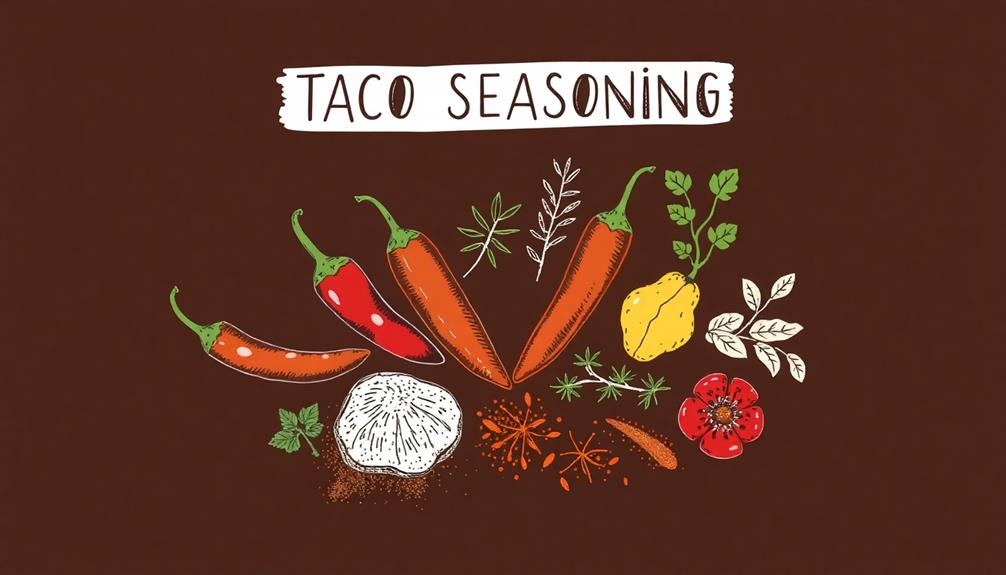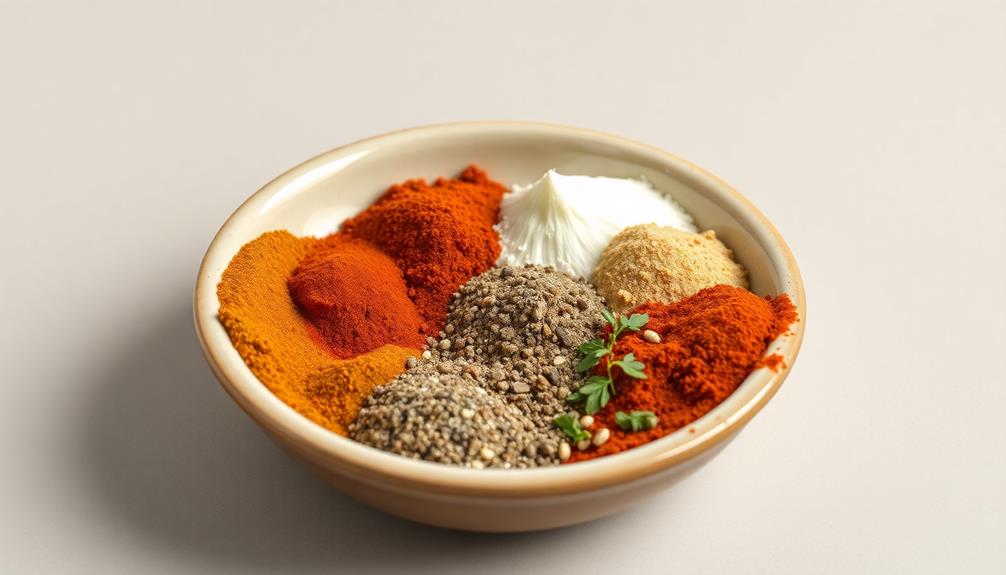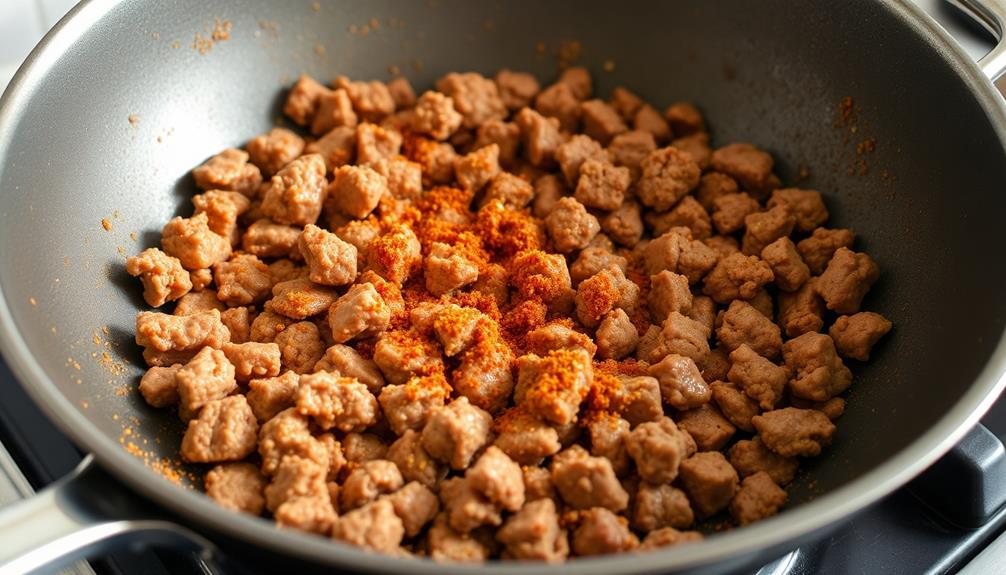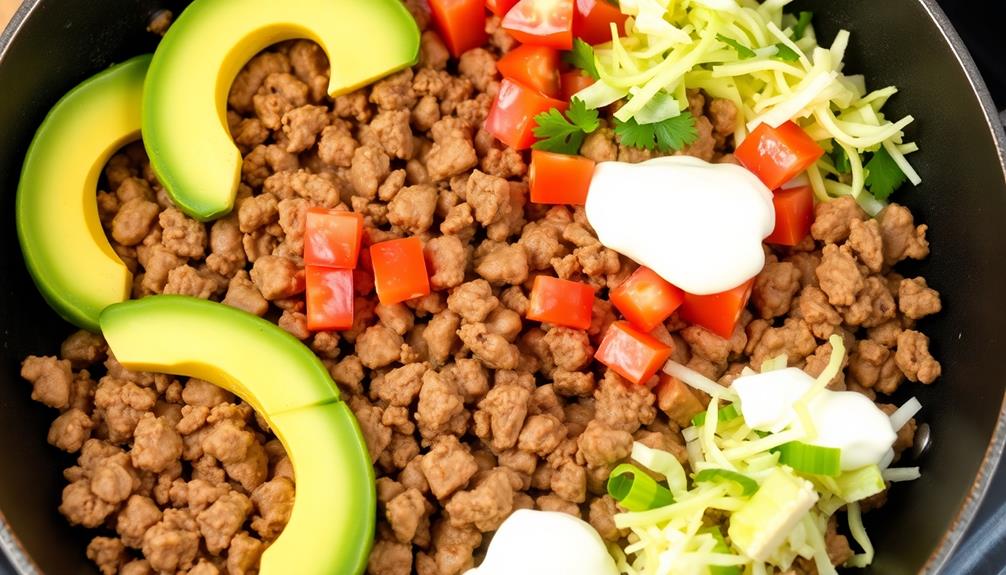Making your own taco seasoning is a simple, cost-effective way to elevate your Mexican dishes. Just combine chili powder, cumin, garlic powder, onion powder, oregano, paprika, salt, and pepper in a bowl. Stir the spices together to create a flavorful blend. You can then use 2-3 tablespoons per pound of ground meat or protein, adjusting to your taste. The homemade seasoning stores well for up to 6 months, allowing you to quickly season your tacos, burritos, and more. This versatile blend also works great in dips, soups, and stews. Want to learn more about the history and cooking steps for this tasty seasoning?
Key Takeaways
- Combine simple pantry spices like chili powder, cumin, garlic powder, and oregano to make a flavorful homemade taco seasoning.
- The taco seasoning can be stored in an airtight container for up to 6 months for future use.
- Add 2-3 tablespoons of the seasoning per pound of ground meat or protein and simmer for 10 minutes to enhance the flavor.
- Homemade taco seasoning is a cost-effective and customizable alternative to store-bought mixes.
- The versatile seasoning can be used in a variety of Mexican-inspired dishes, including tacos, dips, soups, and stews.
History

Taco seasoning has a rich history rooted in the culinary traditions of Mexico. The blend of spices used in taco seasoning has evolved over centuries, with indigenous cultures incorporating local ingredients like chili peppers, cumin, and oregano into their cooking.
As Spanish colonizers arrived in the 16th century, they introduced new spices and techniques, further shaping the flavors of Mexican cuisine.
Throughout the 20th century, taco seasoning became increasingly popular in the United States as Mexican food gained mainstream popularity. Commercial taco seasoning mixes emerged, offering home cooks a convenient way to recreate the bold, savory flavors of authentic tacos.
Today, taco seasoning is a staple in many household pantries, allowing people to easily enhance the taste of their favorite Mexican-inspired dishes. Whether you're making classic ground beef tacos or experimenting with veggie-based fillings, a good taco seasoning can transform the entire meal.
Recipe

Making your own taco seasoning at home is a simple and cost-effective way to add flavor to your favorite Mexican dishes. Not only does it allow you to control the ingredients, but it also gives you the flexibility to adjust the spice level to your personal taste.
This easy taco seasoning recipe is a versatile blend that can be used in a variety of dishes, from ground beef tacos to chicken fajitas. It's quick to prepare and can be stored in an airtight container for future use, making it a convenient addition to your spice cabinet.
Ingredients:
- 2 tablespoons chili powder
- 1 teaspoon ground cumin
- 1 teaspoon garlic powder
- 1 teaspoon onion powder
- 1 teaspoon dried oregano
- 1/2 teaspoon paprika
- 1/2 teaspoon salt
- 1/4 teaspoon black pepper
To make the taco seasoning, simply combine all the ingredients in a small bowl and stir until well mixed. Use the seasoning immediately or store it in an airtight container for up to 6 months.
When using the taco seasoning, start with 2-3 tablespoons per pound of ground meat or protein. Adjust the amount to your desired level of flavor and spice.
The seasoning can also be used to season other Mexican-inspired dishes, such as rice, beans, or vegetables. Enjoy your homemade taco seasoning and the delicious meals it can create!
Cooking Steps

In a small bowl, combine the spices and mix them thoroughly.
Then, add the seasoning mix to your ground meat and simmer the seasoned meat for about 10 minutes.
Serve the flavorful taco meat with your favorite taco toppings.
Step 1. In a Small Bowl, Combine Spices

Take a small bowl and gather the spices for your homemade taco seasoning. In this bowl, you'll combine chili powder, cumin, garlic powder, onion powder, paprika, oregano, and salt. Mix the spices thoroughly until they are well blended, making sure to break up any clumps. This versatile seasoning can be stored in an airtight container for future use in various dishes. After preparing your taco mix, you might want to try something sweet, such as an **eggnog recipe for the holidays**, to complement your festive meals.
The chili powder provides the signature taco flavor, while the cumin adds warmth and depth. Garlic powder and onion powder contribute savory notes, and the paprika lends a subtle sweetness and vibrant color. Oregano offers an earthy, herbal element, and the salt ties all the flavors together.
Once you have all the spices measured out, use a spoon to stir them together until they're evenly distributed. This step is crucial, as it ensures the seasoning will be well-balanced in each taco. You can also give the bowl a gentle shake to further incorporate the spices.
Now that your homemade taco seasoning is ready, you can use it to flavor ground beef, chicken, or vegetables for tacos, burritos, or other Mexican-inspired dishes.
Step 2. Mix Spices Thoroughly

With a spoon, stir the spices together until they're evenly distributed. This crucial step ensures the flavors blend harmoniously, creating a cohesive and balanced seasoning blend.
Take your time and mix thoroughly, making sure there are no clumps or pockets of individual spices. The more you mix, the more the aromas will mingle and intensify, resulting in a more robust and flavorful taco seasoning.
Once the spices are fully incorporated, give the mixture a quick sniff. You should be able to detect the distinct scents of chili powder, cumin, garlic, and the other components. If any one spice seems to be overpowering, you can adjust the ratios accordingly by adding a bit more of the other ingredients.
After mixing, the taco seasoning is ready to be used in your favorite Mexican-inspired dishes. Whether you're seasoning ground beef, chicken, or even vegetables, this homemade blend will elevate the flavor profile and provide an authentic taco experience.
Step 3. Add to Ground Meat

Once your taco seasoning is thoroughly blended, you can start adding it to your ground meat. The amount you use will depend on the quantity of meat, but a general guideline is to add about 2-3 tablespoons of the seasoning per pound of ground beef or turkey.
Begin by browning your ground meat in a skillet over medium-high heat, making sure to crumble it as it cooks. Once the meat is cooked through and no longer pink, drain any excess fat from the pan.
Next, sprinkle the taco seasoning over the cooked meat and stir to combine well. The seasoning will coat the meat evenly, infusing it with the perfect blend of spices.
Let the seasoned meat simmer for 2-3 minutes, allowing the flavors to meld.
At this point, you can use the seasoned ground meat to make your tacos, burritos, or any other Mexican-inspired dish. The taco seasoning adds wonderful flavor and authenticity to your homemade tex-mex creations.
Step 4. Simmer Seasoned Meat for 10 Minutes

After sprinkling the taco seasoning over the cooked ground meat, let the mixture simmer for 10 minutes. This step allows the flavors to meld together and the seasoning to fully incorporate into the meat. The simmering process also helps to thicken the mixture, creating a more cohesive and flavorful taco filling.
During this 10-minute simmer, be sure to stir the mixture occasionally, ensuring even heating and preventing any sticking or burning. The meat should maintain a gentle, steady simmer throughout this time. This low and slow approach allows the spices to bloom and the texture to become more velvety and rich.
Once the 10 minutes have passed, your seasoned ground meat is now ready to be used in a variety of taco dishes. Whether you're making classic tacos, burrito bowls, or taco salads, this perfectly seasoned and simmered meat will be the foundation for a delicious and authentic taco experience.
Step 5. Serve Seasoned Meat With Taco Toppings

Serving the flavorful, simmered taco meat with an array of tasty toppings is the key to creating a truly satisfying taco experience.
Begin by warming soft or crunchy taco shells according to the package instructions. This provides the foundation for your customizable taco.
Next, prepare an assortment of toppings to allow everyone to personalize their tacos. Some classic options include:
- Shredded lettuce or cabbage
- Diced tomatoes
- Sliced avocado or guacamole
- Grated cheddar or Monterey Jack cheese
- Sour cream
- Salsa or hot sauce
Invite your guests to fill their taco shells with the seasoned ground beef or turkey, then top it with their desired combination of ingredients. Don’t forget to offer an array of toppings like shredded cheese, crisp lettuce, diced tomatoes, and tangy salsa so they can customize each bite to their liking. A squeeze of fresh lime or a dollop of sour cream can add that final touch of flavor. If you’re planning another family meal, consider trying out a delicious meatloaf recipe for families—it’s a hearty, comforting dish that everyone will love! For a side option, serve up some warm tortilla chips with guacamole or a zesty queso dip to complement the meal perfectly. This taco night setup is not only fun and interactive but also brings everyone together to enjoy a variety of flavors tailored to their preferences. And when you’re ready to switch up the menu, a delicious meatloaf recipe for families can be your go-to choice for a cozy and satisfying dinner that’s easy to prepare and guaranteed to please.
Encourage experimentation – the options are endless! The beauty of tacos lies in their versatility, allowing everyone to craft their perfect handheld meal.
Savor the harmonious blend of flavors and textures in each delicious bite.
Final Thoughts

With the easy taco seasoning now prepared, you can confidently use it to elevate your favorite Mexican-inspired dishes. The robust blend of spices and herbs will infuse your tacos, burritos, and enchiladas with authentic flavor, making them truly irresistible.
The best part? This seasoning is incredibly versatile. You can use it to season ground beef, chicken, or even roasted vegetables. It's also a fantastic addition to dips, soups, and stews, adding a delightful depth of flavor.
Remember, this recipe makes enough for multiple uses, so don't be afraid to double or triple the batch. That way, you'll always have a jar of this flavorful seasoning on hand, ready to transform your meals in an instant.
With its perfect blend of spices and its convenient make-ahead nature, this easy taco seasoning is a game-changer in the kitchen. Enjoy the bold, zesty taste it brings to your favorite Mexican-inspired dishes and savor the homemade touch it adds to every bite.
Frequently Asked Questions
Can I Substitute Ingredients in the Taco Seasoning Recipe?
Absolutely, you can substitute ingredients in the taco seasoning recipe. Feel free to experiment with different spices and herbs to customize the flavor to your liking. Just be mindful of the balance and proportions to maintain the desired taste.
How Long Does Homemade Taco Seasoning Last?
Homemade taco seasoning can last for several months when stored properly. It's best to keep it in an airtight container in a cool, dry place. With proper storage, your homemade blend will retain its flavor and freshness for up to 6 months.
Can I Use the Seasoning for Other Dishes?
You can certainly use the homemade taco seasoning for other dishes. It's a versatile blend of spices that can enhance the flavor of various meats, vegetables, and even soups or stews. Feel free to experiment and enjoy the versatility of your homemade seasoning.
What's the Difference Between This and Store-Bought Taco Seasoning?
The main difference is that homemade taco seasoning allows you to control the ingredients and adjust the flavors to your taste. It's often fresher and less processed than store-bought versions, which may contain preservatives or fillers.
How Can I Adjust the Spice Level of the Seasoning?
To adjust the spice level of your homemade taco seasoning, you can easily increase or decrease the amount of chili powder, cayenne pepper, or other hot spices to suit your personal preference. Experiment with different ratios to find your perfect blend.









